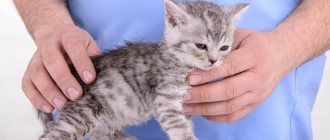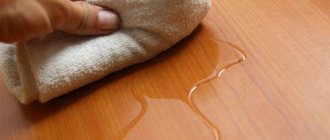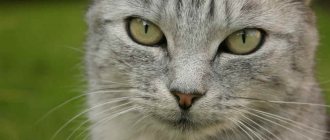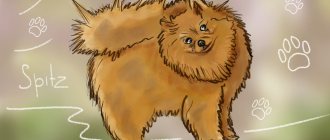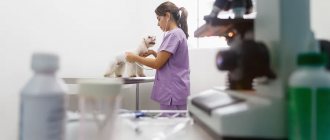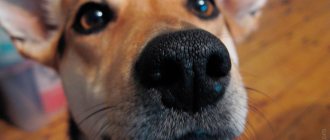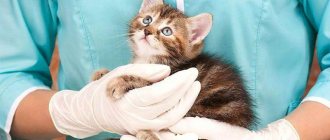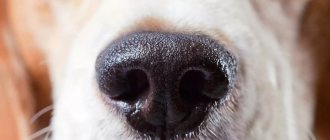Pollakiuria is the term for frequent urination in dogs. This phenomenon may be a harbinger of a developing disease, may signal that the pet is experiencing stress, and sometimes this is the norm. When you should worry and contact a veterinarian, and when you can help your pet at home, this article will help you figure it out.
The frequency of urination depends on the health of the genitourinary organs. The condition of the lower urinary tract affects the storage capacity of the bladder and the nerve pathways that stimulate the act of urination itself.
Thus, frequent urination may indicate a disease of the lower urinary canal, damage to the bladder or urethra.
How often should a dog urinate?
Each dog has its own normal frequency of urination. This largely depends on the regime in which you and your pet live.
If you walk your pet two to three times a day, and he does not have free access to the street, then he will only urinate during these walks (with proper upbringing).
It is worth considering that all dogs behave differently during walks. Some perform their need at one time, while others urinate a little several times during a walk, thus marking their territory.
Here it is important to distinguish the natural process of “marking” from painful frequent urination (a responsible owner will be able to see this from the behavior of the pet).
If your dog has free access to the street (it’s good if it’s a private yard, because self-walking on the street is deadly) or at home there is an adapted toilet (tray or diaper), then the frequency of urination can be about 7-8 times a day. It depends on the size of the dog, the amount of water consumed and some other factors.
It's different for puppies. Up to three months they urinate approximately 12 times a day and during this time they do not control this process.
Injuries
A spinal injury can also be the reason why your dog is urinating more often. The nerve endings or spinal canal are damaged, and complete relief from the problem is unlikely. If this breed of dog also has a long spine, then the likelihood of a problem increases even more. In particular, dachshunds belong to the main risk group.
Childbirth is also a painful process that can affect the development of the problem. Nerves can become pinched and then weakness in the limbs begins, and the appearance becomes painful. It is even likely that the dog will abandon its own puppy. The veterinarian must conduct a comprehensive examination and determine the method of treatment based on the data obtained. The doctor will probably suggest surgery. However, it is better if tests and treatment are done first.
Causes and symptoms
The causes of frequent urination can be divided into natural and pathological.
Natural causes
High water consumption
This occurs during the summer months when it is hot. Or if the dog was active a lot during the day. The more water you consume, the more often you urinate, this is natural. However, if water consumption is many times higher than normal, then this is an alarming symptom called polydipsia.
Overexcitation of the nervous system
Typically, small breed dogs can pee from emotional overstimulation. The individual characteristics of the pet or gaps in upbringing may play a role here. It happens when you don’t spend enough time with your dog. In those rare moments when you pay attention to your pet, she can forget herself in joy.
Stress
If the dog is under stress. Pollakiuria is a common symptom, even if everything is fine with your health. Stress can be provoked by a change of place of residence, the appearance of new pets, punishment, even quarrels between family members, affecting the pet.
Sexual characteristics
It has already been said above that cables can urinate frequently and little by little during a walk. This is how they mark their territory. Neutered females usually do not do this. Bitches usually cope in one or two times during a walk. But when a dog is in heat, frequent urination accompanies this entire period.
If the causes of frequent urination are natural, then usually there are no other symptoms other than pollakiuria and the urine is normal: without impurities, transparent, light yellow. The exception is during estrus. Also, stress can manifest itself as several symptoms, or just one.
Pathological causes and their symptoms
Nephritis, glomerulonephritis and some other kidney damage
Nephritis is an inflammation of the kidneys caused by an infectious agent. A dangerous disease in which all tissues of the kidney are affected, and subsequently the inflammation spreads to the tissues of other organs. If no measures are taken, death is possible. Symptoms:
- frequent urination in small volumes;
- Blood is found in the urine. In some cases, this can only be done by conducting laboratory tests, and in advanced cases, the color of urine even changes due to blood;
- proteinuria (increased protein in the urine, detected during laboratory testing);
- pain when urinating. The dog arches unnaturally and may whine;
- difficulty urinating;
- elevated temperature;
- violent, profuse vomiting;
- the hind legs may be weaned for a short period of time.
Various forms of cystitis
Cystitis is an inflammation of the mucous membrane of the bladder. Often, together with cystitis, there is inflammation of the urethra - urethritis. Symptoms:
- urination is frequent and painful;
- increased body temperature;
- appetite decreases;
- the dog is losing weight;
- vomiting is possible.
Sand in the bladder, kidneys or urethra
If such a pathology is detected, then it is necessary to take therapeutic measures as soon as possible, since stones can form over time. In some cases, this sand can be sharp, which causes extreme pain to the pet. Symptoms:
- urination is frequent, but in very small volumes, sometimes just a few drops come out;
- blood is often found in the urine;
- the main symptom is difficulty urinating due to pain. The dog sits in one place for a long time, strains, and sometimes whines in the process.
Detrusor hyperspasticity (overactive bladder)
The detrusor is a muscle that contracts the bladder when it is full. When this muscle is overactive, the bladder empties even when it is not even half full.
This phenomenon may be associated with the individual characteristics of the dog’s body, but more often this occurs after an injury, when there are disorders of the spinal column, as there is a disruption in the innervation of the bladder. Another name for this pathology is neurogenic bladder.
Symptoms:
- sometimes, such a deviation does not bother the dog in any way, except for frequent urges to go to the toilet;
- in other cases (after injuries), the dog experiences involuntary urination, leakage, etc.
This pathology has different ways of development and manifestations. Many complications are possible, most often urinary tract infections.
If a dog drinks a lot (polydipsia) and urinates frequently (pollakiuria), then the combination of these two symptoms may indicate a number of diseases:
Diabetes
It is an endocrine disease caused by a variety of causes that interfere with insulin production.
Pyometra
This is purulent inflammation of the uterus. Occurs only in unspayed female dogs, usually over five years of age.
The general conclusion regarding the pathological causes of frequent urination (we have listed the main ones) is that in pathologies of the genitourinary organs, pollakiuria is not the only symptom of the disease. Based on the general condition of the pet and accompanying signs, it is easy to suspect a particular disease.
Possible complications
Depending on what disease triggered the thirst attack, complications can be dangerous and even fatal. Especially dangerous are calculi (stones) in the kidneys and pinched nerves in the spine, as well as pyometra.
Stones threaten to block the ureter or urethra, which can lead to an attack of severe pain and the development of very serious complications, including kidney failure or damage to the ureter by the sharp edges of the stone. This can be fatal.
Pinched nerves and displacement of intervertebral discs can lead to complete or partial paralysis and disability of the animal. He will need special conditions or the dog will not survive such a complication.
With pyometra, there is a powerful source of inflammation in the dog’s body. Pus can enter other organs, leading to their infection and the development of an inflammatory process. The most negative diagnosis is sepsis, or general blood poisoning. If the condition is neglected, you may not have time to save your pet.
First aid
The first thing you should do is contact a veterinary clinic for a full diagnosis of your pet.
Attention! You should not give any medications from your home medicine cabinet to your pet. Even if it helped the neighbor's dog. You can only do harm.
All you need to do is provide your pet with enough water (especially if urination is frequent and little by little) and walk it more often.
If there is bad weather outside, if possible, provide the dog with a toilet in the house - lay out a diaper or show a tray (if the dog’s size allows it). The dog's place should be warm so that a draft does not blow in.
If urination is frequent, but without difficulty, in moderate quantities and the urine is normal (light yellow, transparent and without impurities), then it is worth considering that the dog may be under stress.
But even if nothing else bothers your pet, it’s better to play it safe and have his urine tested in a laboratory; perhaps they will find impurities that are invisible to the eye.
What to do
If your dog starts urinating in the house, the first thing to do is take him to a veterinarian to rule out the possibility of a serious illness. If she is suffering from a certain disease, there is a possibility that after treatment the problem will also disappear.
However, if the problem is age-related or chronic and the urinary problem cannot be corrected, consult with your veterinarian to find a compromise solution that will make your dog's care and life easier. You may need to walk your dog or let him outside more often, or designate a place to place the diaper when you are away from home. Dog diapers will also help reduce the number of unpleasant incidents.
Regarding urinary problems due to behavioral difficulties, also consult your veterinarian. For more serious problems, such as separation anxiety, a canine behaviorist can help and prescribe appropriate treatment to address the urinating problem in the home. You can also consult with a dog trainer about a repeat training course to teach your dog the dos and don'ts. To clean the places where the dog left puddles, you should use enzymatic household chemicals to remove the smell and traces of urine and eliminate the possibility of repeated disgrace in the same place.
Don't punish your dog for urinating in the house, as dogs don't always associate bad behavior with punishment, which can make the situation worse. Especially if you leave the dog at home alone, and when you return, you see the consequences in the form of a puddle, but do not catch the dog “in the act.” Despite popular myth, you should not rub her nose in a puddle of urine, as she will likely not make the connection between bad behavior and the appropriate punishment. Instead, focus on rewarding your dog's good behavior when he goes to the toilet outside, such as treats, praise and love. You can even reward her for wanting to go outside when she sits at the front door or rings the bell.
It's hard to stay calm and patient when your dog has ruined your favorite rug or you're tired of cleaning up puddle after puddle, but it helps to see that urination problems are not a sign of defiant defiance, but rather a cry for help. Regardless of whether the problem is behavioral or medical, identifying what it is will help you get rid of it and stop your dog from getting dirty in the house.
Diagnostics
A complete diagnosis is only possible in a clinical setting. First of all, it is important for the veterinarian to know what the pet is fed, whether it is vaccinated, what has bothered it recently, and in general what diseases/surgical interventions the animal has suffered during its life. These questions must be answered by you, the owners.
Then the veterinarian examines the dog and prescribes the necessary laboratory tests, standardly these are blood and urine tests.
If necessary, additional research methods will be prescribed, for example, ultrasound or x-rays.
Treatment
Treatment is prescribed exclusively by a veterinarian after a full diagnosis and diagnosis has been made.
Also, the pet is prescribed a special diet, in which it is very important to maintain the required level of protein and closely monitor water consumption.
Of the ready-made feeds for urinary tract diseases, Royal Canin urinary is usually prescribed.
It is very important to follow all the veterinarian’s recommendations in order to stabilize your pet’s condition and prevent relapses.
Popular questions
Why does a dog urinate frequently after mating?
There may be several reasons for this phenomenon. The most dangerous of them is infection during mating. You can’t do this without the help of a veterinarian. Also, a consequence of mating may be non-infectious inflammation, which provokes frequent urination. This can also be caused by simple hypothermia, so it’s not always the male’s fault.
Also, this may have a natural cause - hormonal fluctuations as a result of estrus and subsequent mating.
Why does a dog urinate frequently during heat?
During estrus, pollakiuria is considered normal; it is associated with a hormonal surge. The dog urinates frequently and in small portions. In the urine you can find viscous mucus with a small admixture of blood. Owners of bitches usually know what is normal for their pet during heat.
Why does my puppy pee often?
Until approximately three months, puppies do not control the process of urination and, normally, pee up to 12-13 times a day. Requiring patience from them to go to the toilet three times is almost impossible.
If you notice that your puppy has difficulty urinating and sits down several times in an hour, then you should contact a specialist.
After spay or neuter surgery
The sphincter directly depends on the amount of hormones released into the blood. If you remove the gonads, disrupting this clear balance, you can get big problems. Veterinarians must warn the owner about this before surgery. For large breeds, the probability of trouble occurring is close to 8-15%, and for small breeds it is about 5%.
There is also a predisposition by breed. Lapdogs, Dobermans, setters, and almost the entire group of schnauzers are highly likely to urinate involuntarily after surgical deprivation of reproductive function. It is impossible to restore all this back. Even hormonal therapy may not give the expected effect due to damaged nerve endings.
Urolithiasis disease
The appearance of stones disrupts the urination pattern and the entire process as a whole. Stones are formed due to health problems, poor diet or dangerous water composition. The stone simply blocks the path of urine, causing dysfunction of the entire system as a whole. The size of these formations can be reduced using ultrasonic crushing or special preparations. If the size is particularly large, only surgical intervention and removal of the foreign body will help.
Cystitis and prostatitis
The first disease is more common in females, while males often suffer from problems with the prostate gland. The entire series of ailments is associated with infections and colds. The most common causes of their occurrence are the following factors:
Sexual relations with stray relatives due to the owner’s oversight can lead to numerous sexually transmitted diseases. Pets living in kennels may develop cystitis and prostatitis during the cold season. This also affects animals that constantly lie on their stomachs and on concrete. You can catch it when swimming in cold water, as well as when walking in the rain and snow. The infectious course can be provoked by concomitant diseases. Viruses, bacteria and fungi enter the genitourinary system from other organs.
The prescribed treatment usually consists of intensive therapy with antibiotics and antibacterial drugs. The prognosis is often positive if everything does not become chronic due to the owner’s oversight.
Briefly about the main thing
- Frequent urination is called pollakiuria.
- The causes of pollakiuria can be natural or pathological.
- Natural ones include: high water consumption in the hot season, emotional overexcitability, stress, estrus in females, marking territory in males during a walk.
- Pathological include: various diseases of the urinary tract (nephritis, cystitis, urolith, sand in the bladder or kidneys, etc.). And also, disruption of neurogenic conduction as a result of injuries to the spinal canal.
- Diagnosis is carried out in a veterinary clinic, since, at a minimum, it is necessary to conduct laboratory tests of blood and urine.
- Treatment is prescribed by a practicing veterinarian; you should not resort to traditional methods, much less use drugs from a human first aid kit without prescription.
